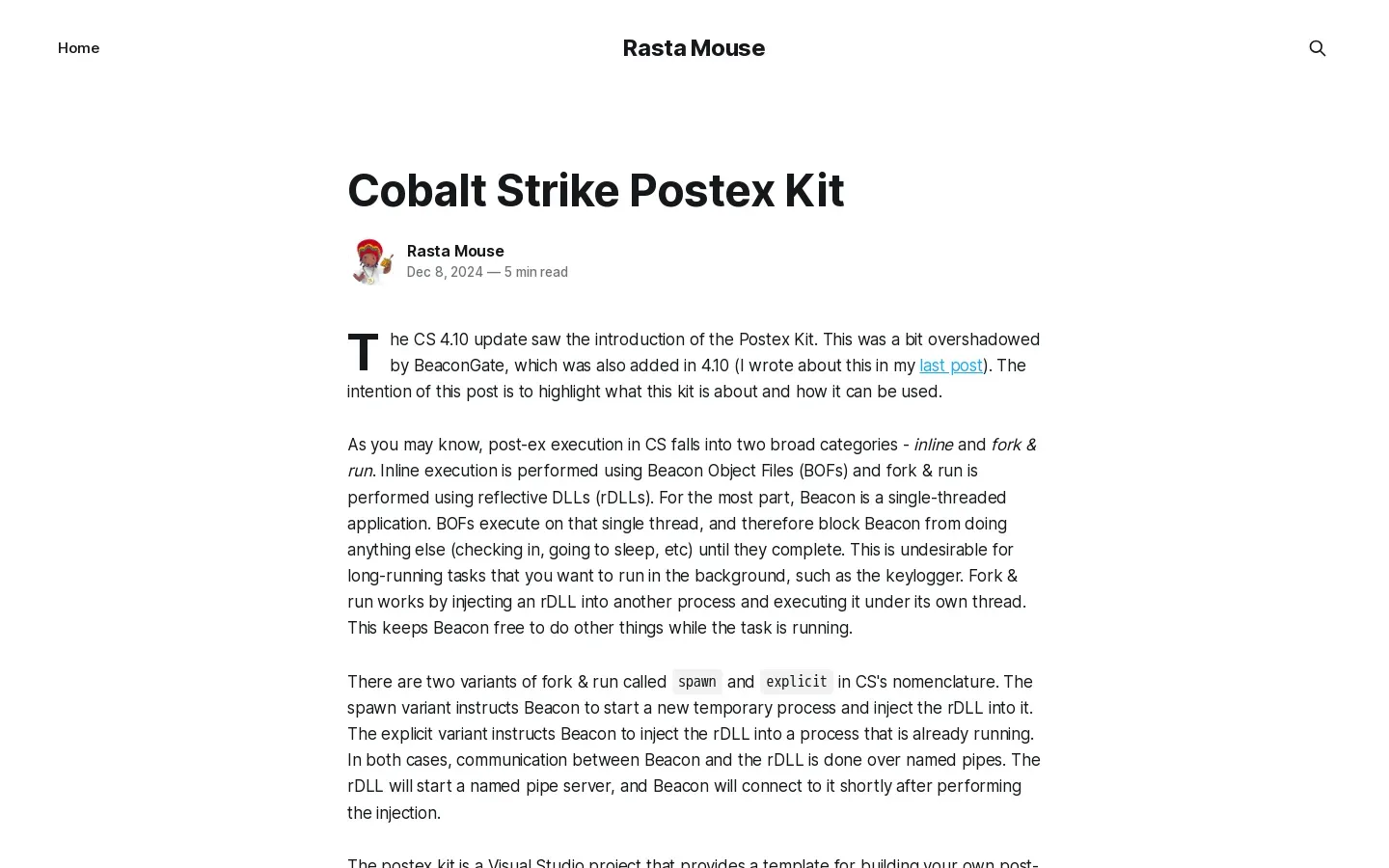
Cobalt Strike 4.10 Update Introduces Postex Kit Features
/ 4 min read
Quick take - The Cobalt Strike 4.10 update introduces the Postex Kit, enhancing post-execution capabilities by allowing users to create long-running tasks and offering two execution methods—inline and fork & run—thereby improving functionality for security professionals and penetration testers.
Fast Facts
-
Cobalt Strike 4.10 Update: Introduces the Postex Kit, enhancing post-execution capabilities for security professionals and penetration testers by allowing long-running tasks within its job architecture.
-
Execution Methods: The update features two primary post-execution methods: inline execution (blocking) and fork & run (non-blocking), with the latter offering more flexibility through ‘spawn’ and ‘explicit’ variants.
-
Communication via Named Pipes: Efficient data exchange between Beacon and reflective DLLs (rDLLs) is facilitated through named pipes, improving task management and responsiveness.
-
Best Practices: Users are advised to implement logging, test in debug mode, monitor named pipe status, and utilize callbacks for effective job management and error handling.
-
Recommended Tools: Key resources include Visual Studio for development, named pipes for communication, and the Aggressor function
bjob_send_data()for real-time data handling in post-execution tasks.
Cobalt Strike 4.10 Update: Enhancing Post-Execution Capabilities with the Postex Kit
Cobalt Strike, a widely-used tool among cybersecurity professionals, has released its latest update, version 4.10, introducing a significant enhancement to its post-execution capabilities through the Postex Kit. This development is set to elevate the tool’s functionality for security experts and penetration testers, offering new methods for managing long-running tasks within Cobalt Strike’s established job architecture.
Key Features of the Postex Kit
The update categorizes post-execution methods into two primary types: inline execution and fork & run. Inline execution utilizes Beacon Object Files (BOFs) and is characterized by its blocking nature, which halts Beacon’s ability to perform other tasks until the current task is completed. This can limit responsiveness during execution.
In contrast, the fork & run method offers a more flexible approach by enabling tasks to run in a separate thread. This ensures that Beacon remains responsive while executing additional commands. The fork & run method itself is further divided into two variants: the ‘spawn’ method, which creates a new temporary process, and the ‘explicit’ method, which injects into an already running process. This versatility allows users to choose the most appropriate method based on their operational needs.
Communication between Beacon and the reflective DLLs (rDLLs) is facilitated via named pipes. The rDLL initiates a named pipe server to enable this communication, allowing for efficient data exchange between the two components during task execution.
Implications for Security Operations
The CS 4.10 update provides users with enhanced capabilities for managing long-running tasks and improves overall responsiveness. As security operations increasingly rely on advanced tools like Cobalt Strike, the Postex Kit’s introduction signifies a step forward in the sophistication and effectiveness of post-execution tactics. This enhancement will likely be welcomed by the cybersecurity community as it offers greater flexibility and control over penetration testing and security assessments.
Best Practices for Optimizing Postex Kit Use
To maximize the benefits of the Postex Kit, users should consider adopting specific strategies:
-
Use Named Pipes for Communication: Utilizing named pipes ensures seamless interaction between Beacon and remote DLLs, facilitating efficient data transfer and streamlined task management.
-
Monitor Named Pipe Status: Implement monitoring checks within long-running processes to ensure graceful exits if connections are lost, preventing potential hangs or resource leaks.
-
Implement Callbacks for Job Management: Using callbacks enhances interactivity and responsiveness by dynamically retrieving job IDs and sending data to registered jobs.
-
Handle Output Appropriately: Effective management of output and error logging within custom DLLs is vital for troubleshooting and improving application reliability.
Common Pitfalls to Avoid
Users should be aware of common mistakes when working with the Postex Kit:
-
Neglecting to Log Output and Errors: Proper logging is essential for identifying issues and ensuring tasks function as intended.
-
Not Testing in Debug Mode: Skipping debug mode testing can lead to runtime errors or unexpected behavior during actual operations.
By addressing these pitfalls, users can enhance their experience with the Postex Kit and ensure smoother operations within Cobalt Strike.
Tools and Resources for Effective Implementation
The tutorial accompanying the Postex Kit emphasizes utilizing appropriate tools:
-
Visual Studio: An integrated development environment (IDE) used for developing applications, including custom rDLLs.
-
Named Pipes: Facilitates communication between Beacon and injected rDLLs for seamless data exchange.
-
bjob_send_data(): An Aggressor function that sends data to a running Postex DLL via a named pipe, enhancing real-time data handling.
These tools collectively enhance Cobalt Strike’s capabilities, allowing users to create and manage custom post-execution tasks efficiently. By leveraging these technologies, operators can ensure a more streamlined workflow, ultimately leading to improved operational outcomes in their engagements.



